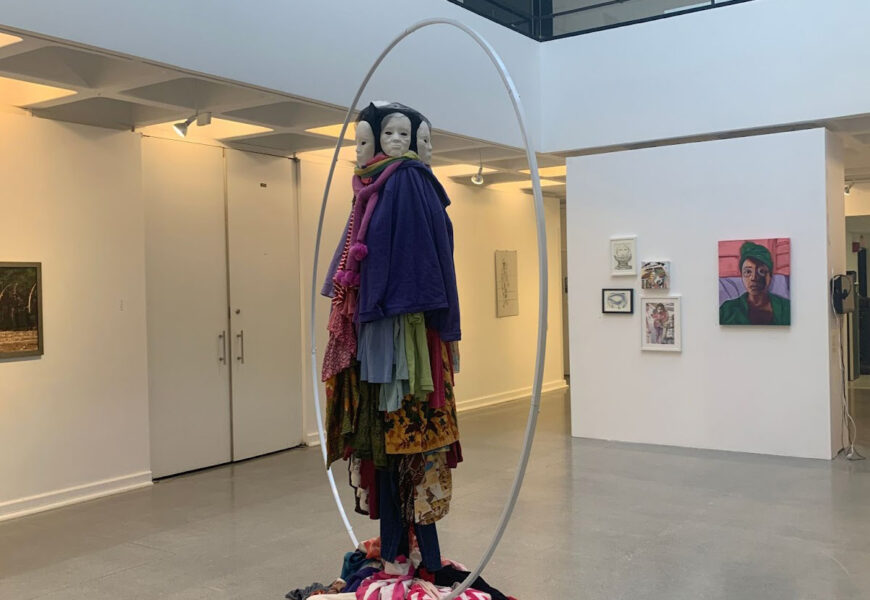Courtesy of Caleb Butler ’26
In the lobby of Cummings Arts Center, there is art. Not renaissance portraits or impressionist landscapes or pristine marble statues. Instead, there are sculptures made of old clothes and used tampons, paintings of women asleep in an idealized Garden of Eden and standing atop a funeral pyre, waving a flag. There is art born from the powerful intersection of anger and hope.
This art installation, “The Will to Change: Gathering as Praxis,” was created by Nasty Women Connecticut (NWCT), an organization with the goal of creating “inclusive platforms for community-building through the arts ,” according to the NWCT website. “The Will to Change,” currently in its sixth iteration, was influenced by the writings of feminist bell hooks. Following hooks’ death in Dec. 2021, NWCT dedicated this exhibit to the work and thoughts espoused by bell hooks, holding at its core hooks’s belief that “healing does not take place in isolation.”
In every iteration, “The Will to Change” aims to include work from artists of any kind to wrestle with the current attacks on women’s rights occurring around the world. Following the recent death of Mahsa Amini in Iran and the overturn of Roe v. Wade in June, along with myriad other acts of sexism happening worldwide, “The Will to Change” makes us think more deeply about these issues and ask ourselves how art can be a vessel for social change. The exhibit also sparks thoughts about how we as a community can more deeply engage with the issues and questions raised by the pieces of art, and how the art itself needs to grow and change in order to better address such issues.
NWCT wants their art to push the boundaries of what “feminist art” can be, what questions it can ask, aiming to further embody bell hooks’ hope of what feminist studies really are, as was written in her book “Feminism is for Everybody”: “Imagine a mass-based feminist movement where folks go door to door passing out literature…to explain to people what feminism is all about.” Beyond finding a way to embody hooks’ teachings, NWCT asks a vital question in “The Will to Change”: What do we do after we exit? This exhibit implores visitors to ask themselves what they will take with themselves after leaving, what this art means, what it can mean, and, most importantly, if it is enough.
Although concepts in “The Will to Change” are relevant to all people, it has a deeper connection to Connecticut College. Professor Luciana Quagliato in the Gender, Sexuality, and Intersectionality Studies Department is a founder of Nasty Women Connecticut and helped bring this exhibit to campus. In her speech at the exhibit’s opening, Quagliato explained, “We have chosen poetry over war, we have chosen art over guns, we have chosen love over hate, we have chosen to gather and build communities over isolation,” and she hopes to reflect that continuous choice in the art displayed in “The Will to Change.”
In a corner of the exhibit, there are a number of bookshelves, surrounded by chairs and pillows. This section of the exhibit is the “un•named zine library,” created by artist and poet Aly Maderson Quinlog, invites all who visit to engage with the work on a more personal level, to seek out what interests them the most about the art they have seen and to think deeply about the ideas that have been presented to them. This library features zines such as “Brained Hair; An Exhibition Catalog with Poetry by Sussy Santana,” “a few things about cempasuchil marigolds,” and “friend music.” The zines included in this library bring “The Will to Change” from an untouchable work of art, merely hanging on the walls to be observed, to something that the community can engage in. Although there is still much work to be done when it comes to community engagement in the issues illustrated in “The Will to Change,” this zine library invites those who otherwise would have been mere viewers of the art to become part of the experience themselves. But, this zine library is not only a place to view zines that have been created by other artists. It also gives people the opportunity to create their own zines and to record their thoughts and feelings on the art they have experienced.
Despite the core ideas of this exhibit and regardless of what the artists are hoping to say with the collection as a whole, the art speaks for itself.
One of the first pieces you see when entering the exhibit – arguably the most striking piece in the collection – is “Eidolon of A-Ngoh,” created by Julie Chen. This piece is simultaneously a sculpture and a costume, donned by Chen in a performance; regardless of how one is able to witness this piece, “Eidolon” is memorable. The sculpture is an abstraction of Chen’s mother, created following her passing using Chen’s mother’s clothing to make up the body and the head, with masks of varying expressions circling the head which was made of her mother’s ashes. Chen described this piece in her artist’s statement as a way for her to process “the death of the person who once gave me life and the many lives she had led.”
Other than “Eidolon,” there are a number of other paintings making up much more of the exhibit. Two of my personal favorites are “Dreamt of God in Blue,” painted by Christina Jones, and “All in the Name of Liberty,” painted by Nathan Lewis. “Dreamt of God in Blue” depicts a young woman lying asleep in a garden, with a blue figure holding her close. This figure has no face, only blossoming flowers where a head should be. In painting this piece, Jones aimed to depict “emotionally engaged narrative paintings with figures among vivid nature dreamscapes and promote creation, spirituality, and sexuality through a queer lens.” Where “Dreamt of God in Blue” examines the role of queerness in religion, “All in the Name of Liberty” raises vital questions of female bodily autonomy. In this painting, Lewis paints a young woman, seen from multiple angles, wearing only a torn white t-shirt. This young woman stands atop a burning pyre despite her bare feet and waves a black flag above her head. By painting this, Lewis wanted to reflect “a belief that the world can and will change, and that it happens now, every day, in the way we see, challenge, take action, and support each other.”
Through all of the art shown in “The Will to Change,” Nasty Women Connecticut asks us to think about what art can mean, what we can take from it, and what it needs to mean for it to make necessary change.










